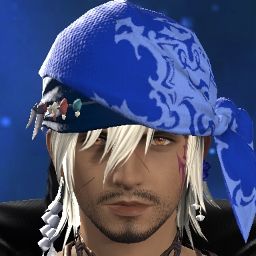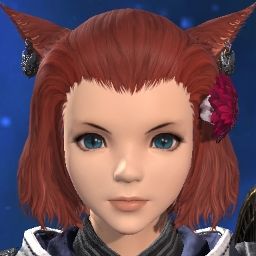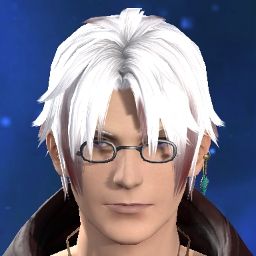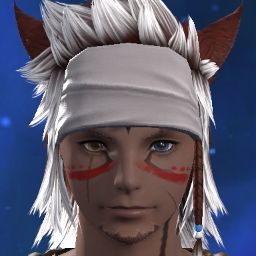Greetings all!
Since before 3.0, many of you have been asking for more information on the dragon language used in FINAL FANTASY XIV. I’ve been putting together something for the past few months, but found that I was getting nowhere close to completing it. The problem was that the more I added, the more I realized I’d forgotten to add. Well, I finally decided that if I kept on doing this, the post would never make its way to the forums, and that wasn’t acceptable, so I sat down at my keyboard and...here we are.
I warn you, the following post is long, somewhat disjointed, and rambling. It covers a lot, but not everything, and may leave you with more questions when (if) you finish. HAVE FUN!
The Birth of a Language
The dragon language was created by me about six years ago, back before the original XIV launch, when Ishgard was still slated to be a part of 1.0. At that time, all the beast tribes were going to have unique tongues (which would be voiced), the Echo simply “translating” those for you in the dialogue window. I threw together some ideas and pitched them to the lore master at that time (Kenichi Iwao, also the world creator on XI) who thought they were interesting enough and asked me to flesh them out. Unfortunately, by the time I had completed my work, it was apparent that Ishgard wasn’t going to make it in 1.0, and my efforts were tossed into a folder that sat on my desktop for almost four and a half years. Fast-forward to patch 2.X. When we were told that the dragons were going to make an appearance to pave the way for the game’s Ishgard-themed expansion, I went straight to the new (and current) lore master’s desk to ask him if it was okay to use the dragon language I had conceived back in the dark ages. He was surprisingly open to the idea...and the rest is history.
An Overview
If I were to describe dragonspeak in one word, it would be “economical”. The dragons (more specifically, the First Brood) have had tens of thousands of years to trim the fat—whether it be from vocabulary, grammar, syntax, or even pronunciation. Multiple meanings have been consolidated into single terms and redundancies eliminated. Words have been shortened, simplified, or condensed to minimize oratory exertion. Instead of differences in meaning being represented by different words, inflection and breath patterns have become the norm. And then there is the simple fact that the beings who use this language have been doing so with the same partners for thousands of years. It is only expected that after communicating with someone for so long, that both parties are, in an sense, able to anticipate what the other will say, further contributing to the abbreviation or omission of obsolete terms, as well as imparting even deeper meaning to words NOT spoken─the ultimate form of reading between the lines.
Languages such as English change over time as millions of people use and refine it in their everyday lives. Those people eventually die after a few decades, and the next generation takes up the process of changing the language, moving it in directions the previous generation may not have even imagined. How many people living in the 19th century would have believed that the word sh*t would come to mean something “great” or “outstanding,” simply by adding the definite article? The path the dragon language takes, however, is largely dictated by the dragons of the First Brood. These select few don’t die after a few decades, and while the language is passed down to their progeny, it is ultimately used to speak with the parents─parents who change little themselves. The result is a paradox in the sense that you have a language that exists in a form that can only be mastered by someone who has been exposed to it for thousands of years...making it difficult for any younger dragons to pick it up themselves, coupled with the unfortunate fact that the lifespan of the latter broods, while still significant, pales in comparison to that of the First.
Dragons Naturally Sounding
Despite their high level of intelligence, the dragons do not have a written language. This means that all written forms of the language are transliterations based on Eorzean (English). While our alphabet can be used to represent most sounds of the dragon tongue, there are some tricky ones that range from quirky to down-right impossible for non-dragons to pronounce. Let’s first start off with two of the most important: [n] and [h].
One of the most basic and unique features of the language is the presence/absence of [life] in words. To the dragons, most words (with some exceptions, of course) represent either a concept that contains or is void of life. Words that are deemed to contain life, such as ‘dragon,’ ‘person,’ and ‘flesh’, will almost always contain a bass-heavy nasal N sound somewhere in them, whereas words without life, such as ‘escape,’ ‘sleep,’ and ‘see’, will always contain what can be best described as a wispy/breathy sound similar to lightly clearing ones throat, but without the...er, juiciness, for lack of a better term. The former is represented in transcribed dragonspeak with an [n], the latter with an [h], to distinguish them from normal ‘n’ and ‘h’ sounds.
Dragon - dra[n]
Person - arr[n]
Flesh - [n]esh
Escape - e[h]sk
Sleep - so[h]m
See - [h]ess
What dragons consider to be ‘life’ is not always as clear cut as ‘living being’ vs ‘inanimate object.’ For example, the word for death, mor[n], contains the life-representing [n]. While to us, death represents the absence of life, the dragons look at it as a part of life—something that would not exist without life—and therefore add that [n]. Another example is [n]oskh, or the word for ‘to ask.’ The dragons believe that life is a journey to search for the reason for existence, and that questions are what bring them closer to that goal. For the dragons, to question is to live. On the other hand, the word for sun, ‘soo[h],’ does not contain an [n] despite being something that is considered by many cultures necessary for the cultivation of life. This is because the dragons─those of the First Brood, at least─understand that the sun is, scientifically speaking, a ball of radioactive plasma floating in the void of space…and have known this fact for a long, long time.
Three additional examples of unique consonants are:
sj sja[h]s (vengeance)
As the transliteration implies, it is a cross between an “s” and a “j”, but in fact it is a bit more complex, containing s+sh+ch+d+j all combined into a rumbling, buzzing compound that, despite containing so many sounds, is spoken at the same speed as a simpler consonant.
ft fta[h]r (after/later)
Another seemingly simple compound sound that is actually quite complex—the “t” sound not being a full stop, but breathed through, placing it somewhere between “t” and “th.”
y dy[h]r (differ/different)
One must be careful not to pronounce this as “ee,” as that may change the meaning of the word. “Y” is actually closer to a “ye” sound, but without the “y” sound being as prominent. The “Y” is effectively swallowed as it segues into the “e,” leaving the listener with something that is clouded at the beginning, but eventually resolves in a long vowel.
I mentioned earlier how inflection and intonation plays a role in the language. These intricacies are transliterated via dots (glottal stops), shapes (rumbling), curved lines (pitch changes), and other types of flourishes (fluttering) above and below the written words. This cannot be reproduced by any of Microsoft’s pre-installed fonts, so I’ve included a picture of some handwritten script.
There is one more very unique sound that plays a prominent role in the dragon tongue, but as it deals directly with tense, I’ve saved it for the next section, which has to do with basic vocab and grammar.
Dragons Naturally Speaking
The basic structure of a sentence is Verb - Object - Subject (as opposed to English which is Subject - Verb - Object). In other words, where in English we would say
"The wombat ate the Lalafell"
the dragons would say
"Ate Lalafell Wombat."
This exhibits how important action is to the dragons as opposed to the initiator of that action. Who ate the Lalafell is (relatively) unimportant. Immediately recognizing that “eating” has occurred readies the dragon to decide on an appropriate action in response.
Speaking of sentence subjects, whereas English employs several types of pronouns, dragonspeak has only the following three:
1st person = a[n] (covers: we and I)
2nd & 3rd person = i[n] (covers you, he, she, they)
3rd person inanimate = a[h] (covers it, that, this, those)
Again, everything has been simplified down to focus on whether or not the action was initiated by the dragons or someone else (a distinction here being made between animate and inanimate things via the inclusion of [n] and [h]).
Adjectives and adverbs will almost always come after the word that they modify, again placing the importance on the action or the object of that action over the words that describe them. The sentence
[slowly ate] {the foolish Lalafell.}
would be constructed in dragonspeak as
[Ate slowly] {Lalafell foolish}
You may notice the lack of articles in the dragonspeak rendition. This is because dragons no longer employ the articles a, an, or the, having come to view them as superfluous and bringing little to a sentence in the way of relevant meaning.
The one slight deviation from modifier order is when a possessive is used. Instead of after the noun, it will come before (as it does in English, but without an apostrophe s).
Thordan’s vengeance - Thor[n] sja[h]s
Possessive pronouns are no different from the pronouns listed above:
My/Our vengeance - a[n] sja[h]s
Your/His/Her/Their vengeance - i[n] sja[h]s
Its vengeance - a[h] sja[h]s
There is next to no conjugation of verbs in dragonspeak─another sign of extreme efficiency. Where in English we have different forms to indicate past or present tense, as well as a compound structure to communicate future tense, dragons use the same word for all three─the only difference being the inhaling of breath while saying the verb to indicate future.
For example, the base word for ‘eat’ in dragonspeak is ee[h]s:
Eat - ee[h]s
Ate - ee[h]s
Will Eat - [s]ee[h]s
The first two are spoken while breathing out, and pronounced like “east” minus the “t,” with the middle of the word heavily aspirated (like the slight soughing of an autumn wind through slowly decaying leaves, or the raspy sigh of an octogenarian’s last breath). The latter is spoken while breathing in─an action that, when performed by a dragon, creates a slight hissing sound that attaches itself to the front of the word. This is represented by [s] when transliterating.
So why is there seemingly no linguistic difference between past and present tense? The reasoning behind this decision lies in how dragons view time and causality. The dragons believe that the present is a culmination of everything that has occurred in the past, essentially making the two one in the same. To put it simply, when one has lived tens of thousands of years, what is happening now is indistinguishable from something that has happened before.
Other verb forms such as present progressive and present perfect also fall under the past/present rules:
Is Eating - ee[h]s (a)
Have Eaten - ee[h]s (for[h])
The key here is the words that accompany ee[h]s. “A” (pronounced like a quick ‘ah’) is the dragonspeak equivalent for “now/in the present.” Using this in conjunction with a verb emphasizes the progressive nature of the verb. “For[h]” is the dragonspeak equivalent for “not now,” and when used with a verb not in the future tense, it can emphasize the fact that something happened at a time not now, but not in the future. Again, as dragons treat past and present as interchangeable, these“forms” are rarely used, and when they are, it is done more so for emphasis rather than the need to make it clear that the dragon is talking about the past or the present as opposed to something else.
Negative sentences are created in a fairly simple manner—by adding an “n” to the front of a verb. This n is different from the life-indicating [n] in that it does not contain the nasal droning. It is a simple, short, hard “n” sound.
nee[h]s fou[n] a[n] - We don’t eat chicken.
One thing that I mentioned in the opening was about how individual words took on more ‘meanings’ through a process of consolidation. A major example of this is how a single word can be used as a noun, adjective, verb, and so forth.
For example, in English, we have
Corrupt (verb) - Corruption (noun) - Corrupted (adjective)
In dragonspeak, however, all of these words are consolidated into “te[n],” dragons being able to understand which meaning the word takes by determining its position in the sentence in relation to other words. Here is an example of how that works:
te[n] le[h]s Thor[n] - Thordan corrupted the land.
[s]to[h]m te[n] Thor[n] - Thordan will bring corruption.
[n] err[n] te[n] Thor[n] - Thordan is a corrupted man.
There is still much more to the language, but short of writing a complete textbook on the subject, it’s looking like it will be impossible to relay all the intricacies without having to quit my day job, so I’m going to stop here.
OR AM I?
Before I wrap things up, I wanted to talk a little about how the language is used in the game and how it contributes to game lore, and to that end I’ve compiled a list of "funfacts" for your enjoyment:
Funfact 1:
Astute observers may have already picked up on the fact that some dragonspeak words appear similar to their Eorzean (English) counterparts. Perhaps these similarities to Eorzean suggest that Eorzean languages may have a root in dragonspeak...!? Some examples include:
come = ko[h]m
new = nuu[h]
anger/hate = ga[h]r
Funfact 2:
An interesting example can be found in the Dravanian forelands. Unlike the Churning Mists, where place names are rendered in dragonspeak because only dragons (and the occasional moogle) reside there, there are quite a lot of Eorzean (English) names on the forelands map, despite being Dravanian lands occupied primarily by dragons for thousands of years. The truth of the matter is that most of these locations DO have dragonspeak names, but the early Eorzeans who settled there misheard the dragon names (which were too complex for them) and instead gave them similar-sounding en equivalents.
The easiest one is Mourn─a corruption of 'mor[n]', meaning 'death', which is the entrance to Sohm Al (promised slumber), where dragons go to end their overlong lives and get some deserved sleep.
Other examples include:
The Whilom River -> wa[h]r a[h]lm (calm water)
Mare’s Oath -> ma[h]r ro[h]s (summer woken)
Halo -> w[h]ei lo[h]s (the path to loneliness)
Funfact 3:
There also happens to be one place on the Azys Lla map that features a name in the dragon language. One may ask how this is possible, as it goes completely against the naming conventions used for other locations in the area. Well, the story behind this is that the name is, in fact, an Allagan creation, not something that the dragons themselves coined. At the height of their civilization, the Allagans felt that they had achieved intellectual supremacy over all other beings on Hydaelyn, the mighty dragons included. Even the dragon language, once believed impossible to crack, was fully deciphered by Allagan linguists─or so they claimed. Using the ‘impossible’ language became a fad, and dragonspeak was, for a time, incorporated everywhere from restaurant names to cereal brands. The claw-like formation in the Delta Quadrant—Esh Thom—is an attempt by an Allagan to make a play on the dragonspeak word for god “es[h]e[h]d,” which is, in fact, a compound meaning “highest spirit.” The Allagan who coined the term took the e[h]d portion (highest) and replaced it with “t[h]om” (bottom-most), possibly to express the late Allagan civilization’s departure from matters theological and their disdain for those who still adhered to their belief in an almighty being watching over them. It turns out that the joke was on the Allagans, as not only did a planet-wide calamity put an end to their reign over Hydaelyn, but the name Esh Thom does not translate into “the lowest of spirits,” but more closely to “an underdeveloped spirit,” a trait which can possibly be attributed to the fall of their people.
Funfact 4:
So, how is the translation of dragonspeak lines actually handled? The flow is a tad unorthodox, but basically...
1. The Japanese is submitted by the scenario team.
2. The English translation is done, prepping it for dragonspeak by cutting the fat and reducing it to its core meaning (using the economization techniques mentioned above). If that core meaning is not clear, we'll often work directly with the writer to determine the most important portions of the message to ensure we are not omitting anything that the writer wishes to remain.
3. I, personally, do the dragonspeak translation. If I am ever unable to perform my duties as dragonspeak translator...then I suppose the dragons would stop talking.
4. The dragonspeak is reviewed by the original English translator and the English is adjusted if necessary.
5. I do a simple recording of the lines for the voice actors (as some of the lines subtleties/pronounciation) cannot be relayed via written text.
6. Voice recording is done by the English voice actors (for use in all language versions)
7. Effects are added by the sound team
In Conclusion
If this whole thing feels...
...overly convoluted
...like it shouldn’t work
...like there are too many holes in the framework
...like there are too many things that would lead to confusion
then I’ve succeeded (somewhat, at least), as this is exactly the type of language I wanted to create—something that felt like it was ever-so-close, but always just out of reach. Something that, in our hubris, we humans have convinced ourselves (as did the Allagans) we could learn, conquer, and thus, make our own...but ultimately, at the end of the day, have failed at doing so. However, that doesn’t mean we can't have fun trying to succeed where the Allagans failed!
Cheers!
PS: A partial dragonspeak dictionary (about 200 terms) will be posted tomorrow as a sticky (right by the Roegadyn dictionary). It is nowhere near complete, but it covers most of the language found in game, whether it be on maps, in item names, or in spoken dialogue.
Thread: A Lesson in Dragonspeak
-
10-07-2015 03:35 PM #1
A Lesson in Dragonspeak
(147)Last edited by Fernehalwes; 10-08-2015 at 09:36 AM. Reason: hinterlands -> forelands
-
10-07-2015 04:03 PM #2Player

- Join Date
- Aug 2013
- Location
- Gridania
- Posts
- 1,580
- Character
- Marik Destiel
- World
- Hyperion
- Main Class
- Summoner Lv 100
Wow, just wow! That was quite the enjoyable read, and I'm so amazed at the intricacies of this language for dragons. So many faux pas could be made even attempting to try to communicate with a dragon in dragon speak! It's so intriguing and yet so baffling! Kudos all around! I'm still trying to wrap my head around all of this honestly, but you seem to be happy with that thought I'm sure of lol.
(5)
Signature by: Miste
-
10-07-2015 04:24 PM #3Player

- Join Date
- Jan 2014
- Location
- Limsa Lominsa
- Posts
- 528
- Character
- Lyland Battersea
- World
- Chocobo
- Main Class
- Summoner Lv 80
This is absolutely fascinating. Makes me wish Square-Enix would consider publishing a full-fledged lore compendium for FFXIV, in English and other languages for international audiences. There's already quite a fair bit available to allow for independent tabletop RPG campaigns, old-school style.

But in an article like this, I can't help but succumb to the hazards of my profession, and point out that English is an S-V-O language, not S-O-V. Even the example you used above ("The wombat [subject] ate [verb] the Lalafell [object]") is in SVO, not SOV. You may have been thinking about Japanese instead. ^^;;(6)Last edited by TinyRedLeaf; 10-07-2015 at 04:30 PM.
-
10-07-2015 04:35 PM #4
Thanks TinyRedLeaf.
Simple case of brain meltdown on that SVO/SOV mixup.
You're right, I've probably been in Japan too long...
Original post edited.
Cheers!(16)
-
10-07-2015 04:42 PM #5Player

- Join Date
- Dec 2012
- Location
- Ala Mhigo
- Posts
- 8,306
- Character
- Enkidoh Roux
- World
- Balmung
- Main Class
- Paladin Lv 90
-
10-07-2015 04:43 PM #6Player

- Join Date
- Aug 2013
- Location
- Ul'dah
- Posts
- 1,313
- Character
- Doranaux Wavemet
- World
- Goblin
- Main Class
- Gladiator Lv 80
Thanks Fern, this is great! The funfacts are especially cool, I feel like even the tiniest pieces of Eorzea are a story. The lore and localization continue to be my favorite part of FFXIV.
(4)A true paladin... will sheathe his sword.
-
10-07-2015 04:56 PM #7Player

- Join Date
- Mar 2014
- Location
- Limsa Lominsa
- Posts
- 593
- Character
- Kharagan Dotharl
- World
- Balmung
- Main Class
- Dark Knight Lv 90
Thanks for taking the time to make this post! Highly informative and enjoyable.
(1)
-
10-07-2015 05:15 PM #8
Thanks \o/
(1)
-
10-07-2015 05:31 PM #9
To be able to write these (or approximations) using Word you can use the Equation Editor. In 2013 go to Insert -> Equation -> Matrices -> and select empty 3x1 matrix (typing the actual letter in the middle box). You can then approximate your notation with a large number of different symbols instead of writing them by hand, placing them in the top or bottom box. It might not be as easy when an accent covers multiple characters though.
(1)Last edited by Shem; 10-07-2015 at 05:37 PM.
-
10-07-2015 05:43 PM #10


 Reply With Quote
Reply With Quote














